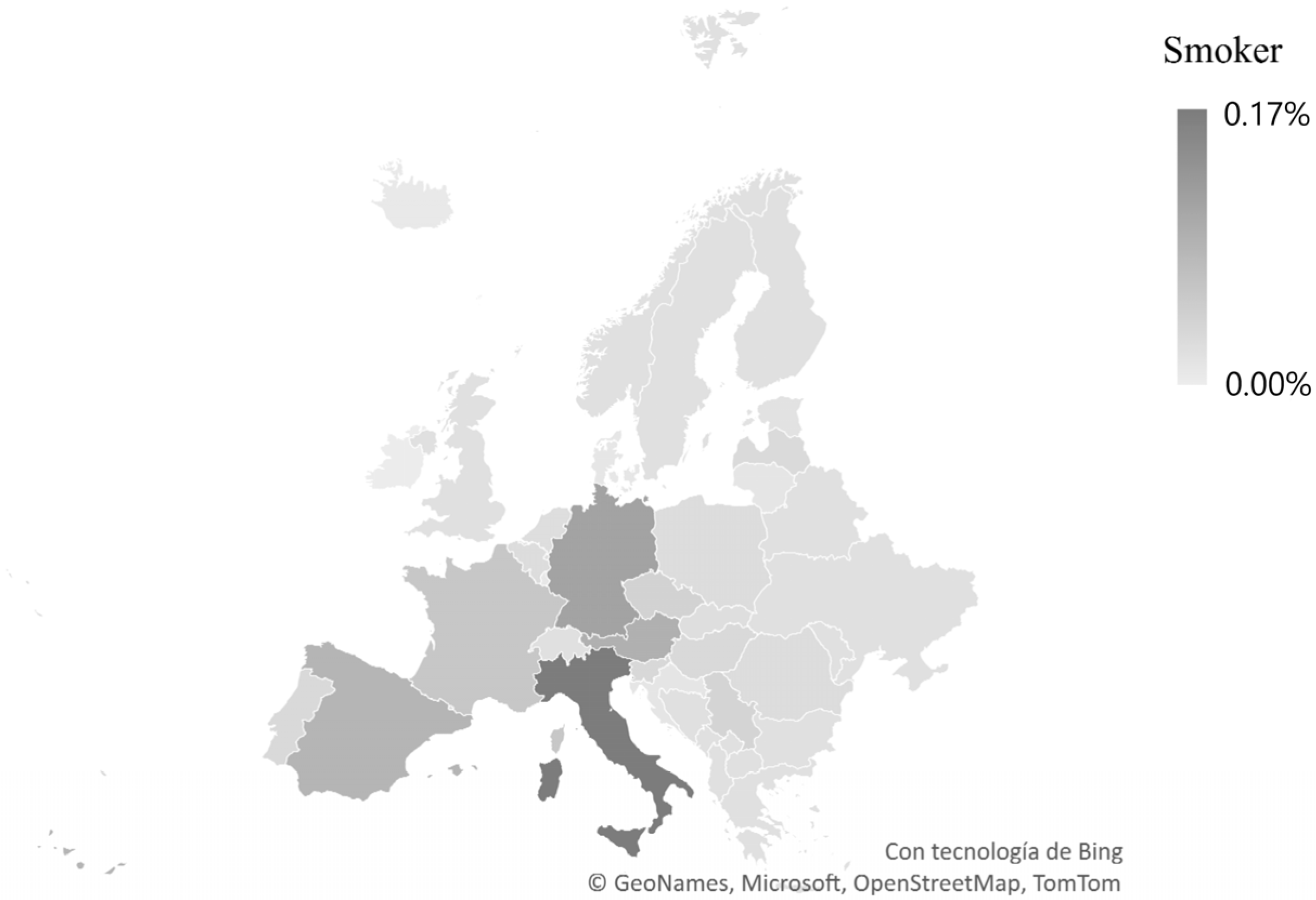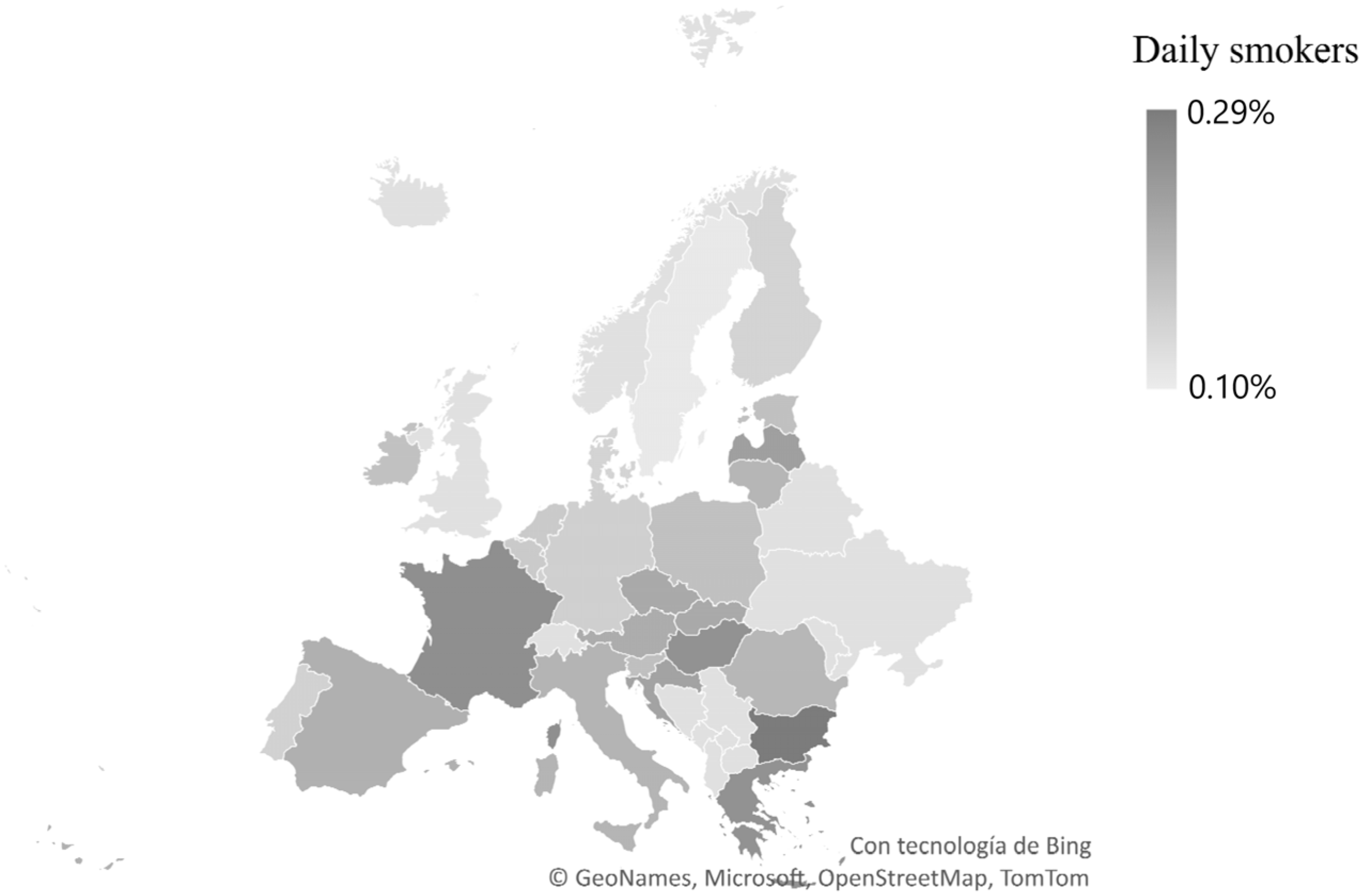Taxes on the consumption of certain products have played a key role in public revenue analysis in European countries. The global market for alternative risk-reduced tobacco products, such as e-cigarettes, heated tobacco products (HTPs), nicotine pouches, and snus, has been rapidly growing. As these products are relatively new, there is a lack of consensus among policymakers on how to regulate them, particularly in terms of taxation.
1. Tobacco and National Taxes
The cultivation and consumption of tobacco have long been intertwined with European societies, economies, and health systems. As European countries have sought to address tobacco’s economic and health-related challenges, taxation has emerged as a crucial policy instrument. This section aims to explore the relationship between tobacco cultivation taxation and the distribution of consumers in Europe, focusing on how variations in taxation policies influence consumer behaviors, market dynamics, and public health outcomes.
Tobacco cultivation taxation serves as a vital revenue source for many European countries while also acting to regulate tobacco consumption. By levying taxes on the cultivation of tobacco, governments can control the supply chain, influence the pricing of tobacco products, and potentially discourage consumption. However, the effectiveness of taxation policies depends on various factors, including the level of taxation, the presence of alternative tobacco and nicotine products, and the prevalence of illicit trade.
Consumer behavior plays a pivotal role in shaping the demand for tobacco and nicotine products. High tobacco cultivation taxes often lead to increased retail prices, which may deter some consumers from purchasing tobacco products. Consequently, this section examines how varying levels of taxation can influence smoking prevalence rates and patterns of tobacco use across different demographic groups. Analyzing consumer behavior in response to taxation is essential for understanding the potential impact of taxation policies on public health outcomes.
The distribution of tobacco consumers across Europe is not uniform, and taxation policies can contribute to regional disparities in tobacco consumption. Some countries may adopt more aggressive tobacco taxation strategies, resulting in reduced consumption rates, while neighboring countries with lower taxation levels might experience higher tobacco use. Taxation policies can inadvertently create opportunities for the illicit trade of tobacco products (Table 1). When taxes lead to substantial price differences between neighboring countries, consumers may turn to illegal channels to acquire cheaper tobacco products.
Table 1. Tobacco and cigarette taxation in the EU countries.
One significant factor contributing to differences in traditional combustible tobacco consumption across Europe lies in its rich history and diverse cultural influences. European countries have distinct tobacco-related traditions dating back centuries. For instance, Mediterranean countries such as Italy and Greece have a long-standing tradition of tobacco cultivation and consumption, often in the form of hand-rolled cigarettes and cigars. In contrast, Northern European nations may have adopted tobacco consumption at different points in history, with varying cultural norms and habits. These historical and cultural differences play a pivotal role in shaping tobacco consumption patterns, with preferences for specific tobacco products deeply embedded in regional identities. Another compelling reason behind the disparities in traditional tobacco consumption in Europe is the socioeconomic diversity among its member states. Countries within the European Union exhibit significant variations in income levels, education, and access to healthcare. Socioeconomic disparities can translate into varying rates of smoking prevalence. In some wealthier European nations, higher incomes and greater access to smoking cessation programs have contributed to lower smoking rates. Conversely, in less economically developed regions, where tobacco may be more affordable and fewer resources are allocated to anti-smoking initiatives, smoking rates tend to be higher. However, the situation is not so clear-cut. Some higher-income countries still show high prevalence rates (and high intensity of use) in adults, such as France and Germany. The simple differentiation between high- and low-income countries does not seem enough to explain the final results. Within-country income level disparities play an important role, too. These disparities highlight some of the complex interplays between economic factors and tobacco consumption behaviors Figure 1.
Figure 1. Distribution of traditional combustion tobacco consumers in Europe. Source: Authors’ analysis from
[1] (Wave 3—2020).
Another different approach is the analysis of the percentage of daily smokers in Europe (Figure 2). The analysis of the percentage of daily smokers in Europe is justified by its specific focus on individuals who maintain a higher and more regular level of tobacco consumption. This is relevant because daily smokers are at greater risk of experiencing the long-term adverse effects of tobacco compared to occasional smokers. Concentrating on this demographic group gives a more detailed understanding of the true burden of smoking in terms of public health. This information is crucial for designing effective public health policies and planning targeted interventions aimed at reducing tobacco consumption and, ultimately, mitigating the severe health consequences associated with smoking for the population.
Figure 2. Daily smokers in Europe. Source: Authors’ analysis from OECD database.
2. Tobacco Competitive Markets and Their Failures
According to classical economic theory, the conditions for considering a market to be competitive are mainly four. First, the existence of many suppliers and demanders must be considered. Second, there must be perfect information, i.e., all market participants must have information about the risks and opportunities that arise. Thirdly, the product must be homogeneous and practically non-differentiable. Finally, there should be no barriers to market entry and exit.
However, despite the guidelines provided by theory, experts know that in practice, markets function in a much more complex way. This is what, in the end, has come to be classified as a market failure. These failures are classified into three types: externalities, imperfect or asymmetric information, public goods, and market power.
Externalities are consumption, production, or investment decisions made by individuals, households, or firms that affect third parties that do not necessarily participate in the market. This market failure has indirect effects on the consumption and production opportunities of third parties who do not directly participate in these transactions. However, the price of the product taken into consideration does not reflect this impact. As will be discussed below, such effects may be positive (as in the case of education) or negative (as in the case of sugar, alcohol, and tobacco consumption).
3. Negative Externalities Tax Policies’ Measures
The specific case studied here, that of RRPs as a new alternative to traditional combusted tobacco consumption, can be understood as a change in the status of the externality of consumption. The direct health effects will not only affect those who use it but will also have a significant impact on third parties. The question, therefore, arises here: How to optimally correct the costs caused by a negative consumption externality?
The state generally deals with the reduction of the social cost associated with a negative externality of consumption through regulation, taxation, and the education of society. The first two measures are generally the most effective in the short term. However, the design of regulation and taxation is not a simple task. This is why policymakers make use of expert opinions and expertise in carrying out such a task.
Combusted tobacco consumption is widely regarded as a negative externality due to its harmful effects on smokers and non-smokers. According to ref.
[2], the negative health consequences associated with combusted tobacco use extend far beyond the individual smoker and can have significant impacts on broader society. This is because the smoke produced by the combustion of tobacco contains numerous harmful substances that can cause a wide range of health problems, including cancer, heart disease, and respiratory illnesses. Non-smokers who are exposed to second-hand smoke are also at risk of developing these health problems, creating a negative externality for individuals who have not chosen to smoke.
Furthermore, combusted tobacco consumption has a significant economic impact on society. According to a report by the World Health Organization
[3], the costs associated with combusted tobacco use are substantial and include both direct healthcare costs as well as indirect costs related to decreased productivity and increased absenteeism. These costs are borne by society rather than just by individual smokers, making combusted tobacco consumption a negative externality. The World Health Organization (WHO) report notes that the economic burden of combusted tobacco use is particularly high in low- and middle-income countries, where healthcare systems may be less equipped to handle the health consequences of smoking.


